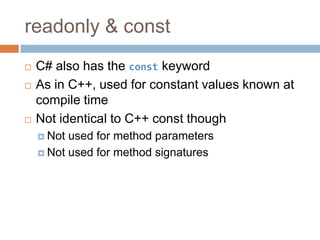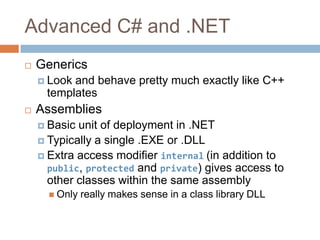C# for C++ programmers
- 1. C# for C++ ProgrammersA crash course
- 2. C#: the basicsLots of similarities with C++Object-orientedClasses, structs, enumsFamiliar basic types: int, double, bool,…Familiar keywords: for, while, if, else,…Similar syntax: curly braces { }, dot notation,…Exceptions: try and catch
- 3. C#: the basicsActually much more similar to JavaEverything lives in a class/struct (no globals)No pointers! (so no ->, * or & notation)Garbage collection: no delete!No header filesNo multiple inheritanceInterfacesStatic members accessed with . (not ::)In a nutshell: much easier than C++
- 4. Hello, world!using System;// Everything's in a namespacenamespace HelloWorldApp{// A simple classclass Program {// A simple field: note we can instantiate it on the same lineprivate static String helloMessage = "Hello, world!";// Even Main() isn't global!static void Main(string[] args) {Console.WriteLine(helloMessage); } }}
- 5. C# featuresPropertiesInterfacesThe foreach keywordThe readonly keywordParameter modifiers: ref and outDelegates and eventsInstead of callbacksGenericsInstead of templates
- 6. PropertiesClass members, alongside methods and fields“field” is what C# calls a member variableProperties “look like fields, behave like methods”By convention, names are in UpperCamelCaseVery basic example on next slide
- 7. Properties: simple exampleclass Thing{// Private field (the “backing field”)private String name;// Public propertypublic String Name {get { return name; }set {// "value" is an automatic // variable inside the settername = value; } }}class Program{static void Main(string[] args) {Thing t = new Thing(); // Use the settert.Name = "Fred"; // Use the getterConsole.WriteLine(t.Name); }}
- 8. PropertiesSo far, looks just like an over-complicated fieldSo why bother?
- 9. Properties: advanced getter/setterclass Thing{// Private field (the “backing field”)private String name;private static intrefCount = 0;// Public propertypublic String Name {get { returnname.ToUpper(); } set {name = value;refCount++; } }}Can hide implementation detail inside a propertyHence “looks like a field, behaves like a method”
- 10. Properties: access modifiersclass Thing{// Private field (the “backing field”)private String _name;// Public propertypublic String Name {get { return _name; }private set {_name = value; } }}Now only the class itself can modify the valueAny object can get the value
- 11. Properties: getter onlyclass Thing{ // Public propertypublic intCurrentHour {get { returnDateTime.Now.Hour; } }}In this case it doesn’t make sense to offer a setterCan also implement a setter but no getterNotice that Now and Hour are both properties too (of DateTime) – and Now is static!
- 12. Properties: even simpler exampleclass Thing{// Private field (the “backing field”)private String _name;// Public propertypublic String Name {get { return _name; }set {_name = value; } }}class Thing{// If all you want is a simple // getter/setter pair, no need for a // backing field at allpublic String Name { get; set; }// As you might have guessed, access // modifiers can be usedpublic boolIsBusy { get; privateset; }}
- 13. PropertiesA really core feature of C#You’ll see them everywhereDateTime.NowString.Lengthetc.Get into the habit of using a property whenever you need a getter and/or setterPreferred to using GetValue(), SetValue() methodsNever use public fields!
- 14. InterfacesVery similar to interfaces in JavaOr M-classes (mixins) in SymbianLike a class, but all its members are implicitly abstracti.e. it does not provide any method implementations, only method signaturesA class can only inherit from a single base class, but may implement multiple interfaces
- 15. foreachSimplified for loop syntax (familiar from Qt!)int[] myInts = new int[] { 1, 2, 3, 4, 5 };foreach (intiinmyInts){Console.WriteLine(i);}Works with built-in arrays, collection classes and any class implementing IEnumerable interfaceStringimplements IEnumerable<char>
- 16. readonlyFor values that can only be assigned during constructionclass Thing{ private readonlyString name;privatereadonlyintage =42;// OKpublic Thing() { name = "Fred";// Also OK}public void SomeMethod() { name = "Julie";// Error}}
- 17. readonly & constC# also has the const keywordAs in C++, used for constant values known at compile timeNot identical to C++ const thoughNot used for method parametersNot used for method signatures
- 18. Parameter modifiers: refNo (explicit) pointers or references in C#In effect, all parameters are passed by referenceBut not quite...static void Main(string[] args) {String message = "I'm hot";negate(message);Console.WriteLine(message);}static void negate(String s) { s += "... NOT!";}Result:> I'm hot
- 19. Parameter modifiers: refAlthough param passing as efficient as “by reference”, effect is more like “by const reference”The ref keyword fixes thisstatic void Main(string[] args) {String message = "I'm hot";negate(ref message);Console.WriteLine(message);}static void negate(refString s) { s += "... NOT!";}Result:> I'm hot... NOT!
- 20. Parameter modifiers: outLike ref but must be assigned in the methodstatic void Main(string[] args) {DateTime now;if (isAfternoon(out now)) {Console.WriteLine("Good afternoon, it is now " + now.TimeOfDay.ToString()); }else {Console.WriteLine("Please come back this afternoon."); }}static boolisAfternoon(out DateTimecurrentTime) {currentTime = DateTime.Now;returncurrentTime.Hour >= 12;}
- 21. DelegatesDelegates are how C# defines a dynamic interface between two methodsSame goal as function pointers in C, or signals and slots in QtDelegates are type-safeConsist of two parts: a delegate type and a delegate instanceI can never remember the syntax for either!Keep a reference book handy…
- 22. DelegatesA delegate type looks like an (abstract) method declaration, preceded with the delegate keywordA delegate instance creates an instance of this type, supplying it with the name of a real method to attach toExample on next slide
- 23. Delegates// Delegate type (looks like an abstract method)delegate intTransform(intnumber);// The real method we're going to attach to the delegatestatic intDoubleIt(intnumber) { return number * 2;}static void Main(string[] args) {// Create a delegate instanceTransform transform; // Attach it to a real methodtransform = DoubleIt; // And now call it (via the delegate)intresult = transform(5);Console.WriteLine(result);}Result:> 10
- 24. Multicast delegatesA delegate instance can have more than one real method attached to itTransform transform;transform += DoubleIt;transform += HalveIt;// etc.Now when we call transform(), all methods are calledCalled in the order in which they were added
- 25. Multicast delegatesMethods can also be removed from a multicast delegatetransform -= DoubleIt;You might start to see how delegates could be used to provide clean, decoupled UI event handlinge.g. handling mouse click eventsBut…
- 26. Multicast delegates: problemsWhat happens if one object uses = instead of += when attaching its delegate method?All other objects’ delegate methods are detached!What if someone sets the delegate instance to null?Same problem: all delegate methods get detachedWhat if someone calls the delegate directly?All the delegate methods are called, even though the event they’re interested in didn’t really happen
- 27. EventsEvents are just a special, restricted form of delegateDesigned to prevent the problems listed on the previous slideCore part of C# UI event handlingControls have standard set of events you can attach handlers to (like signals in Qt), e.g.:myButton.Click += OnButtonClicked;
- 28. Advanced C# and .NETGenericsLook and behave pretty much exactly like C++ templatesAssembliesBasic unit of deployment in .NETTypically a single .EXE or .DLLExtra access modifier internal(in addition to public, protected and private) gives access to other classes within the same assemblyOnly really makes sense in a class library DLL
- 29. Further readingReference documentation on MSDN:http://msdn.microsoft.com/en-us/libraryMicrosoft’s Silverlight.net site:http://www.silverlight.net/StackOverflow of course!http://stackoverflow.com/C# in a Nutshell – highly recommended!http://oreilly.com/catalog/9780596800956/Free MS Press eBook: ProgrammingWindows Phone 7http://www.charlespetzold.com/phone/



![Hello, world!using System;// Everything's in a namespacenamespace HelloWorldApp{// A simple classclass Program {// A simple field: note we can instantiate it on the same lineprivate static String helloMessage = "Hello, world!";// Even Main() isn't global!static void Main(string[] args) {Console.WriteLine(helloMessage); } }}](https://image.slidesharecdn.com/cforcprogrammers-110823044039-phpapp02/85/C-for-C-programmers-4-320.jpg)


![Properties: simple exampleclass Thing{// Private field (the “backing field”)private String name;// Public propertypublic String Name {get { return name; }set {// "value" is an automatic // variable inside the settername = value; } }}class Program{static void Main(string[] args) {Thing t = new Thing(); // Use the settert.Name = "Fred"; // Use the getterConsole.WriteLine(t.Name); }}](https://image.slidesharecdn.com/cforcprogrammers-110823044039-phpapp02/85/C-for-C-programmers-7-320.jpg)







![foreachSimplified for loop syntax (familiar from Qt!)int[] myInts = new int[] { 1, 2, 3, 4, 5 };foreach (intiinmyInts){Console.WriteLine(i);}Works with built-in arrays, collection classes and any class implementing IEnumerable interfaceStringimplements IEnumerable<char>](https://image.slidesharecdn.com/cforcprogrammers-110823044039-phpapp02/85/C-for-C-programmers-15-320.jpg)


![Parameter modifiers: refNo (explicit) pointers or references in C#In effect, all parameters are passed by referenceBut not quite...static void Main(string[] args) {String message = "I'm hot";negate(message);Console.WriteLine(message);}static void negate(String s) { s += "... NOT!";}Result:> I'm hot](https://image.slidesharecdn.com/cforcprogrammers-110823044039-phpapp02/85/C-for-C-programmers-18-320.jpg)
![Parameter modifiers: refAlthough param passing as efficient as “by reference”, effect is more like “by const reference”The ref keyword fixes thisstatic void Main(string[] args) {String message = "I'm hot";negate(ref message);Console.WriteLine(message);}static void negate(refString s) { s += "... NOT!";}Result:> I'm hot... NOT!](https://image.slidesharecdn.com/cforcprogrammers-110823044039-phpapp02/85/C-for-C-programmers-19-320.jpg)
![Parameter modifiers: outLike ref but must be assigned in the methodstatic void Main(string[] args) {DateTime now;if (isAfternoon(out now)) {Console.WriteLine("Good afternoon, it is now " + now.TimeOfDay.ToString()); }else {Console.WriteLine("Please come back this afternoon."); }}static boolisAfternoon(out DateTimecurrentTime) {currentTime = DateTime.Now;returncurrentTime.Hour >= 12;}](https://image.slidesharecdn.com/cforcprogrammers-110823044039-phpapp02/85/C-for-C-programmers-20-320.jpg)


![Delegates// Delegate type (looks like an abstract method)delegate intTransform(intnumber);// The real method we're going to attach to the delegatestatic intDoubleIt(intnumber) { return number * 2;}static void Main(string[] args) {// Create a delegate instanceTransform transform; // Attach it to a real methodtransform = DoubleIt; // And now call it (via the delegate)intresult = transform(5);Console.WriteLine(result);}Result:> 10](https://image.slidesharecdn.com/cforcprogrammers-110823044039-phpapp02/85/C-for-C-programmers-23-320.jpg)





